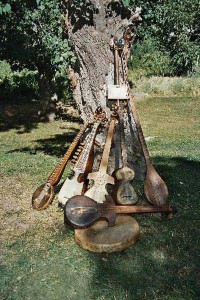I Wish I’d Been There
Light the candle of wisdom within your heart,
And hurry, heart aglow, to the worlds of light.
If you would light a lamp within your heart,
Make knowledge and action your wick and oil.
– Nasir Khusraw [1]
By Nourmamadcho Nourmamadchoev
Nasir Khusraw woke from a dream that incited a gnawing curiosity within; the beginning of a long journey in the year 1045 CE. He travelled to the court of the Fatimid Imam-Caliph al-Mustansir in Cairo, Egypt where he studied for seven years. Here he was invited to the Imam’s palace, where the Imam commissioned him to spread the Fatimid teaching:
“Shāh Nāṣir,” said Imam al-Mustansir, “you should set off towards Khurasan, Badakhshan and Balkh for the sake of calling people to the Summons of the Truth. I have appointed you as my Hujjat (Proof) in this region.” [2]
I wish I’d been in his company when he received this invitation.
The arrival of Nasir Khusraw in Badakhshan heralded a new change and implementation of novel rituals: he arranged gatherings of people (majlis) called majlis-e-dawat in the villages, later to unfold into majlis-e- Charagh Rawshan and madda-khani. These two religious rituals are prevalent and an important facet of the rituals among the Ismaili communities in Badakhshan and its neighbouring regions.
Charagh rawshan is a majlis or a daʻwat – a gathering of believers, where a lamp is lit and Qur‘anic verses recited for the eternal peace of a departed soul. The recitation of the Quranic verses is followed by madda khani till dawn – a time when the text of Charagh Nama (consisting of selected Qasidas) is recited. When the khalifa reads the text of Charagh Nama the participants chant in unison a praise to God, the Prophet Muhammad and Imams from his ahl al-bayt.
Local stories narrate that the tradition of Charagh rawshan and madda-khani arrived in the region with the missionary activity of Nasir Khusraw. According to local tradition, the first person who started to sing madda was a local ruler Malik Jahan Shah, who even renounced his throne in order to serve the Hujjat of al-Mustansir. [3]

Pamiri Rubabs
I wish I’d been present in a congregation where Nasir gave a rubab (musical instrument) to Malik Jahan Shah and asked him to recite didactic poetry – a madda. The very first ode – qasida – Malik Jahan Shah sang was a marvellous poem in praise of Imam Ali, which reads:
My tongue utters praise to ‘Ali,
My two lips unceasingly utter Ya Ali.
My head prostrates in worship to the Lord,
My thirty two teeth invoke Ya Ali. [4]
Thus, these local traditions that were preserved among the Ismailis of Badakhshan have been imparted from one generation to the next, thus linking past with the present. It is evident from the daily life of the local population that Pir Nasir Khusraw’s intellectual foresight combined with philosophical tradition still exerts a great influence among the Nizari Ismaili communities in Badakhshan and its adjacent regions. Although, the local narrative story is traditional in nature, it still brings forward certain important historical issues related to the figure of Nasir Khusraw and his missionary activities in the region as well as the tradition of Charagh rawshan and madda-khani, which were set up as part of religious assemblies.
The incontrovertible historical fact of Nasir Khusraw visiting the region remains alive in the tradition founded a thousand years ago by him. This tradition connects the destiny of the Ismailis of the region with their ‘Present and Living Imam’ Shah Karim al-Husayni – His Highness the Aga Khan.
The invocation from the Charagh rawshan: “ ‘allahuma sali ‘ala sayyidana Muhammadin wa ‘ala ali ‘Aliyan va Muhammad salawat bar Muhammad va ‘Ali,” [5] which was, is and always will be reiterated by youngsters and elderly of these small mountainous communities in Badakhshan, is a testament to this belief and fact.
© Simerg.com
________________
[1] Hunsberger, A. Nāsir Khusraw, The Ruby of Badakhshan: A Portrait of the Persian Poet, Traveller and Philosopher, London: I. B. Tauris, 2000, p.
[2] Fidāī Khurāsānī, Muhammad Zayn al-‘Ābiddīn. Ta‘rīkh-i Ismā‘īlīiya yā Hidāyat al-Mu’minīn al-Tālibīn, Tehran, 1373, p. 79
[3] This story is drawn from a local narrative history called Bahr al-Akhbar, a short treatise on the life and activity of Nasir Khusraw in Badakhshan, which is ascribed to the pen of a certain Sayyid Jalal-i Badakhshi. Local tradition narrates that upon joining the da’wat of Nasir Khusraw, Malik Jahan Shah became known as Baba ‘Umari Yamgi. See: Sayyid Jalal-i Badakhshi. Bahr al-Akhar, Edited by: Rahmonqulov, R, Khorugh: Pamir, 1992
[4] Tavakkalov, H. S. Janri Madhiya dar Folklori Badakhshan, Unpublished MA Thesis, Dushanbe, 2005, p. 18.
[5] This particular text of salwat used to be chanted in chorus by the people who participate in the daʻwat-i Nasir. The current text of Charagh Nama has a short form of the salwat, which is Allahumma Sali ʻala Muhammadin wa Ali Muhammad.
_______________
About the writer: Nourmamadcho Nourmamadchoev is originally from Badakhshan. In 1997, he obtained his BA degree from Khorog State University in Arabic and Persian languages and literature. In 2001 he was enrolled into Khorog English Programme sponsored by the Institute of Ismaili Studies (IIS). After completing this programme he was selected to continue his studies at the Graduate Programme in Islamic Studies and Humanities at the IIS. In 2004, he was enrolled into one year MPhil course in Middle East and Islamic Studies, Cambridge University, which he completed in August 2005. He is now doing a Ph.D in History at the School of Oriental and African Studies, University of London.
______________
1. Please do not miss A Fida’i Mission: Into Saladin’s Tent, which has been simultaneously published on the same day as this reading
2. Please click I Wish I’d Been There or visit the home page www.simerg.com for links to other published articles in this special series.
3. We welcome feedback/letters from our readers. Please use the LEAVE A REPLY box which appears at the bottom of this page, or email it to simerg@aol.com. Your feedback may be edited for length and brevity, and is subject to moderation. We are unable to acknowledge unpublished letters.



A strange content: Interestingly , the writer a local of Badakhshan/Pamir, is unable to put-up any verse from the Diwan of Nasir Khusraw (NK) or any reference of his published ( or even a manuscript) regarding the “ritual” , presently performed on the third night (after burial in Gilgit-Baltistan and Chitral – GBC).The text, Chiragh-Nama (CN), as used by the writer, is called, alternately or both, sometimes, as “dawat-e Nasiri” (DN) , as well, in GBC. The text of the CN/DN has gone through various “make-ups” particularly by Nazim-ud-dawat, Qudratullah Baig during the late Fifties of the last century and lastly during the Eighties of the last century, under some waizeen nominated by ITREB from GB & C Regions where 99.98 % Ismailis belong, as per their claim, to the tradition of Pir ( actually it is the Hujjat of Khurasan as one cannot find the word “pir” in the Fatimid, Alamut and Post Alamut Times literature; but, only after 16th century as W.Ivanow said somewhere in an Introduction to a work, perhaps ‘Haft Bab’ by Abu yaqub. We can see obviously that the majority of the verses, in CN/DN are not from NK exept a few inserted in the now globally implemented, with options open , text for the performance of the Ritual by the members of the Pamiri/Badakhshani and in addition to GB&C of Pakistan By adopting something that we cannot substantiate from the person whom we are ‘identifying’ as the founder is in fact myth-building and could become a problematic for the future generations.
Excellent. Very Inspiring article
Thank you for this enlightening article full of knowledge and information for us the readers. I have often wondered what difficulties Dai Nasir Khusraw had in his dawa work. I would like to know what literature are available with the information of the life and works of this enlightened soul and the Imam’s devoute dai.
May Allah grant you peace, good health and his Batani
Didar.
Phenomenal deed! May the people of Badakhshan never drift away from the preaching of Pir-Shah Nasir in the way of Truth.
May the “Nur” of Muhammad (s) always be with You dear Nourmamadsho. My all best wishes with You. With Ya Ali Madad.
A good piece. Articles such as yours contribute to a better understanding of the Ismaili Tariqa. Keep up your efforts.
I wish I was also there to witiness the ceremony.
May Allah bless you with lots of success and barakat
Thank you for this reading. It was really very nice and I wish you happiness and success in every step of your life.
Nicely done in explaining Nasir Khusraw’s special connection to Badakhshan and how the people of the region keep his teachings alive.
Well done! A task which every mother would want their sons to do… Well done! Blessings and best wishes.
Yasmin
I was very pleased to read the article. It is full of knowledge and wisdom. No doubt, the teachings of Nasir Khusraw enlighten the soul. I have experienced Chiragh Roshan a number of time at Dawat Fina and Dawat Baqa. I cannot express what one feels when the dawat is in progess. You feel touching spiritual heights within few moments.
I pray for your success!!
Very very touching and wise points! I wish you good luck and success in further achievements. May God bless you on the way chosen by you – never stop!!!!!